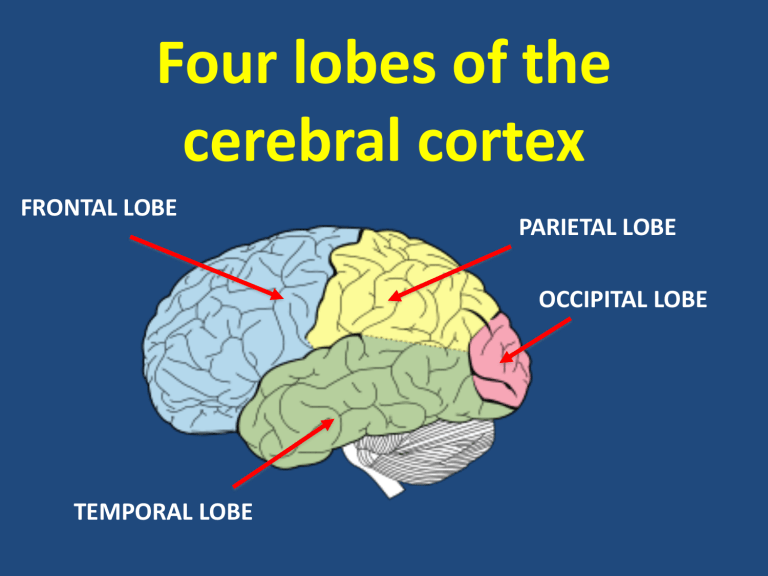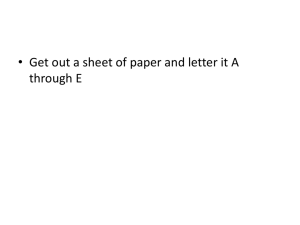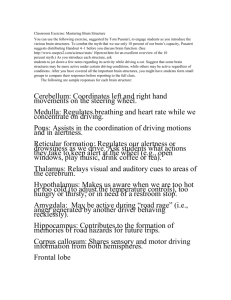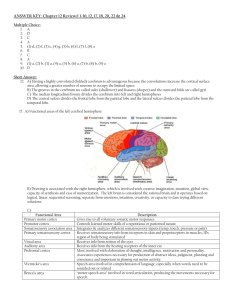Four lobes of the cerebral cortex

FRONTAL LOBE
Four lobes of the cerebral cortex
PARIETAL LOBE
OCCIPITAL LOBE
TEMPORAL LOBE
• Each cortical area (lobe) is associated with different structures and functions
• Named after the bone in the skull they lie beneath
• Each lobe contains:
– Sensory areas and/or
– Motor areas
– Association areas
FRONTAL LOBES
• Largest lobe, located in the upper forward section of EACH cerebral hemisphere
• Contains the primary motor cortex
– Runs laterally (across) the top of the brain at the rear of the lobe
• primary motor cortex is characterised by:
1. Contra-lateral organisation – left motor cortex controls voluntary movements on the right side of the body and vice versa
2. Topographically (how they are mapped out) - The size of the motor cortex devoted to body parts reflects the dexterity of the part.
3. Inverse representation of body – feet at top and face at bottom
Primary motor cortex…
Homonculus of the motor cortex
Frontal lobe continued…
• Association areas:
– Higher mental functioning such as reasoning, planning, judging and using initiative
• Also involved in personality and emotional behaviour
• EG Phineas Gage – change of personality
Example - Phineas Gage
• Railway construction supervisor, 1848.
• After an accidental explosion, and iron rod (3.5cm diameter,
1m long & 6kg) was shot through his skull, damaging his frontal lobes
• His personality, social behaviour and temperament changed after the incident.
• Phineas lived for a further 12 years
Phineas Gage Skull
Broca’s Area
• Located in left frontal lobe
– Near face, tongue, jaw and throat of motor cortex
• Involved in production of clear fluent & articulate speech
• Broca’s aphasia (expressive aphasia) – damage to area – a language disorder characterised by an impaired ability to produce speech
• Can understand others, can read, but likely to have difficulty with speaking (motor) and poor grammar and pronunciation. Know what they want to say but can’t get the words out.
• So: Poor grammar, slow and laboured speech
– Mainly verbs and nouns, no conjunctions
– (May have difficulty interpreting the meaning of words if the usual order of words is changed)
• E.g. “here….head…..operation…here…speech… none…. talking…..what….illness….”
PARIETAL LOBES
• Located at the top and centre of the brain between the frontal and occipital lobes of
EACH cerebral hemisphere
• Involved in functions such as:
– Sense of touch
– Detection of movement
– Location of objects in the surrounding environment
Primary somatosensory cortex
Contains the primary somatosensory cortex
Runs laterally (across) the top of the brain at the front of the lobe primary somatosensory cortex is characterised by:
1.Contra-lateral organisation – left somatosensory cortex receives sensory information from the right side of the body and vice versa
2.Topographically (how they are mapped out) - The size of the somatosensory cortex devoted to body parts reflects the sensitvity of the part.
3.Inverse representation of body – feet at top and face at bottom
Homunculus of the sensory cortex
Comparison of sensory & motor homunculus
Parietal lobes cont…
• Association areas :
– Sense our body in space (using information from visual and auditory cortex)
– Determining where objects are in the environment (using visual and spatial reasoning)
• Damage to the parietal lobe association areas:
– May result in ‘Neglect Syndrome’ i.e. ignoring the left side of the ‘world’
– May result in spatial disorientation e.g. unable to find the way home
OCCIPITAL LOBES
• Located at the back of the brain
• Contains the primary visual cortex
– Receives visual information from photoreceptors
(rods and cones ) in the back of the eye
• Association Area:
– Allows us to form visual perceptions, think visually and remember visual things
What might occur if there is damage to the occipital lobe?
TEMPORAL LOBES
• Located in the lower, central area of the brain
• Used in auditory perception, memory, visual perception & recognising faces
• Contains the primary auditory cortex
– Receives and processes auditory information
• Has different locations for different aspects of sound (pitch, frequency etc)
• Association Areas:
– Involved in memory & linking emotions
– Involved in facial recognition
Wernicke’s Area
• Located in left temporal lobe
– Near primary auditory cortex
• Involved in comprehension of speech, interpreting sounds , and locating appropriate words to express meaning
• Wernike’s aphasia (receptive aphasia) – no trouble with a word’s pronunciation or grammar but the words chosen may be inappropriate and the meaning may be expressed in a round about way . Also, difficulty with understanding the meaning of the spoken word.
• So:
– Causes fluent, meaningless strings of words
– Sounds like normal speech, but makes no sense
• E.g. “I was over the other one, and then after they had been in the department, I was in this one”
• Besides Wernicke’s aphasia, what other problems might arise as a result of damage to the temporal lobe?








